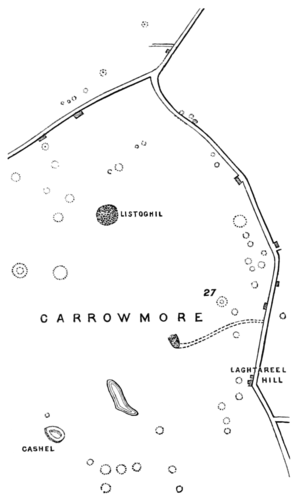art is to be found. There are stone cairns, with dolmens in their interiors—dolmens standing alone, but which have been evidently always exposed; dolmens with single circles; others with two or three circles of stones around them; and circles without dolmens or anything else in the centres. The only form we miss is the avenue. Nothing of the sort can now, at least, be traced, nor does it seem that any of the circles possessed such appendages.
The annexed woodcut (No. 58) will explain the disposition of the principal group. It is taken from the Ordnance Survey, and is perfectly correct as far as it goes, but being only on the 6-inch scale, is too small to show the form of the monuments.[1] In the centre is, or rather was, a great cairn, called Listoghil. It is marked by Petrie as No. 51, but having for years been used as a quarry for the neighbourhood, it is now so mined that it is difficult to make out either its plan or dimensions. Petrie says it is 150 feet in
- ↑ I regret very much that the state of my health, and other circumstances, prevented my mapping and drawing these remains, but I hope some competent person will undertake the task before long. Carrowmore is more easily accessible than Carnac. The inns at Sligo are better than those at Auray, the remains arc within three miles of the town, and the scenery near Sligo is far more beautiful than that of the Morbihan; yet hundreds of our countrymen rush annually to the French megaliths, and bring home sketch-books full of views and measurements, but no one thinks of the Irish monuments, and no views of them exist that are in any way accessible to the public.

